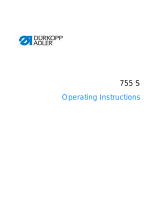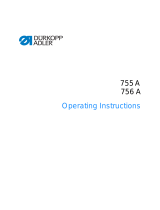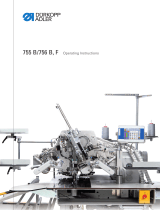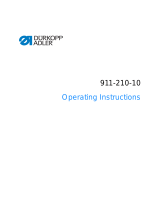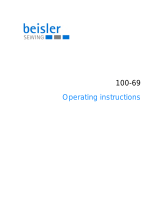Page is loading ...

Manual, complete
745-34
Sewing unit for runstitching of piped flap
and welt pocket openings and pocket corners
Working methods: A, B, D, F
Operating Instructions
Installation Instructions
Service Instructions
Instructions for Programming DAC
Postfach 17 03 51, D-33703 Bielefeld • Potsdamer Straße 190, D-33719 Bielefeld
Telefon + 49 (0) 5 21 / 9 25-00 • Telefax + 49 (0) 5 21 / 9 25 24 35 • www.duerkopp-adler.com
1
2
3
4
Ausgabe / Edition: 01/2004 Printed in Federal Republic of Germany Teile-Nr./Part.-No.: 0791 745161

745 - 34
Manual, complete
Summary
Operating Instructions
Installation Instructions
Service Instructions
Instructions for Programming DAC
Interconnection-diagram
9870 745100 B
9870 745115 B
9870 745116 B
9870 001018 B
Pneumatic circuit plan
9770 745003

Index Page:
Part 2: Installation Instructions 745-34
1. Scope of delivery.............................................. 3
2. General notes ................................................ 3
3. Installing the sewing unit
3.1 Transport ................................................... 4
3.2 Removing the security devices ...................................... 5
3.3 Setting the working height ......................................... 6
3.4 Adjusting the foot pedals .......................................... 7
4. Attaching the machine parts removed for shipping
4.1 Thread reel holder .............................................. 8
4.2 Cylinder for pick-up folder stroke ..................................... 9
4.3 Workpiece boxes .............................................. 10
4.4 Fastening the holder for control panel, bobbin winder and right-hand tray ............. 11
4.5 Table extension (optional equipment) .................................. 12
4.5.1 Table extension for working method with bundle clamp carriage .................. 12
4.5.2 Table extension for stacking to the side for 745-34 A and 745-34 D ................ 13
4.6 Throw-over stacker (optional equipment) ................................ 14
5. Electrical connection
5.1 Connecting the control panel DAC II C.................................. 16
5.2 Connecting the external bobbin winder ................................. 16
5.3 Making the mains connection ....................................... 16
5.4 Checking the nominal voltage ....................................... 17
5.5 Checking the nominal voltage of the vacuum device (optional equipment) ............ 18
5.6 Direction of rotation of the sewing motor ................................ 18
6. Pneumatic connection .......................................... 19
7. Connection to the factory-own vacuum unit............................. 20
8. Oil lubrication ................................................ 21
9. Commissioning ............................................... 22

2

1. Scope of delivery
–
Basic sewing unit for runstitching of piped, flap and welt pocket
openings with rectangular and slanted pocket corners, consisting
of:
–
Height-adjustable stand
–
Step motors for sewing drive, material feed, length adjustment
of the corner incision device
–
Twin needle lockstitch machine
–
DAC II C control with control panel
–
Laser marking lamps
–
Sewing light
–
Compressed air maintenance unit with compressed air pistol
–
Thread reel holder
–
Workpiece boxes for additional parts to the left of the operator
and underneath the table top
–
Tools and small parts in the accessories
–
Feeding and sewing equipment according to the working
method
–
Optional equipment
2. General notes
ATTENTION !
The sewing unit must only be assembled by trained specialist staff.
Any work on the electrical equipment of the sewing unit must
only be carried out by electricians or correspondingly instructed
persons.
The mains plug must be pulled out.
The enclosed operating instructions of the step motor manufacturer
have to be observed in any case.
3

4
3. Installing the sewing unit
3.1 Transport
For in-house transport the stand is equipped with four castors.
ATTENTION !
Do not lift the sewing unit at the table tops.
Use an elevating platform truck or a forklift truck.
ATTENTION!
Before commissioning the sewing unit screw out the stand feet 2 and 3
until a secure footing is achieved.
Lifting the sewing unit
–
Push the elevating platform truck or the forklift forks into the
openings 1 at the back of the sewing unit.
Rolling the sewing unit
–
For transport purpose unfasten the stand feet 2 and 3 by turning
them to the right.
–
After transport secure the sewing unit by turning the stand feet 2
and 3 to the left.
23
1

3.2 Removing the securing devices
Before installing the sewing unit all six securing devices have to be
removed.
If the sewing unit has to be transported to another place, please use
the securing devices again.
5

3.3 Setting the working height
The working height can be set between 77 cm and 108 cm
(measured up to the upper edge of the table top).
The sewing unit is set to the lowest working height of 77 cm by the
manufacturer.
–
Turn the table top to the desired height with crank 1.
–
To the right = Table top higher
–
To the left = Table top lower
ATTENTION: Danger of breakage !
Crank 1 must not be actuated before the 3 securing screws 2 have
been removed.
6
1

3.4 Adjusting the foot pedals
The distance of the foot pedals to the operator is adjustable.
–
Loosen screws 1, 2, 4 and 5.
–
Push the base plate 3 with the pedals into the desired position.
–
Tighten screws 1, 2, 4 and 5 again.
7
12 3 4 5

4. Attaching the machine parts removed for shipping
4.1 Thread reel holder
–
Insert the thread reel holder 2 in the drill-hole of the table top
and fasten it with nut 4 underneath the table top.
–
Mount and align the reel plate 1 and the unwinding arms 3 as
shown in the illustration.
8
321
4

4.2 Cylinder for pick-up folder stroke (745-34 B/F)
–
Remove the securing device and swivel the cylinder upwards.
–
Fasten the cylinder fixture 1 to plate 3 with screws 4.
–
Move the fixture for the pick-up folder by hand.
The movement must be fingertip easy over the whole cylinder
stroke.
Correction
–
Loosen screws 3 a little and move the fixture for the pick-up folder
over the whole cylinder stroke.
In the course of this the cylinder fixture aligns itself.
–
Tighten screws 3.
–
Check the free movement once again.
9
432 1

4.3 Workpiece boxes
–
Fasten the workpiece boxes onto rod 2.
For this purpose push the clamping pieces 4 and 3 on rod 2, align
the height and clamp them firmly by tightening the screws.
–
Loosen the screw at clamping lever 1 and align the workpiece
boxes to the sewing station.
–
Tighten the screw at clamping lever 1.
10
4 321

4.4 Fastening the holder for control panel, bobbin winder and right-hand tray
Control panel
–
Fasten angle 6 and control panel 5 to bolt 3 with nut 4.
–
Fasten cable 1 to bolt 3 with screw 2.
Bobbin winder and tray
–
Push holder 11 with angle 10 onto the table top and tighten with the
screw.
–
Align the arms 9 and 12.
–
Fasten the tray 8 to the lower arm.
–
Fasten the bobbin winder 7 to the upper arm.
See chapter 5.2 for connecting the bobbin winder.
11
6 543 21
12 11 10 9 8 7

4.5 Table extensions (optional equipment)
4.5.1 Table extension for working method with bundle clamp carriage (Order No. 0745 597674)
–
Fasten the table extension 3 onto the table top brace with the
screws 2.
–
Loosen screws 1 slightly.
Create a clearance to the table top by shifting the table extension 3.
This clearance is required for the free passage of the positioned
pocket bag.
12
321

4.5.2 Table extension for stacking to the side (Order No. 0745 597684)
–
Fasten table extension 2 to the front of the rest table brace with the
screws 1.
–
Screw angle 3 on table top 4 with two screws.
13
21
43

4.6 Throw-over stacker (optional equipment)
The throw-over stacker 1 (Order No. 0745 597554) is fastened to the
stand of the sewing unit with mounting pipe 2.
–
Fasten the mounting pipe 2 in the right stacking opening 4 with
screws, washers and shackle 3.
–
Push the throw-over stacker towards the stand of the sewing unit.
–
Fasten spars 5 and 6 on spar 2 with the shackle and the two
brackets 7.
–
Insert the coupling plug of the compressed air supply (thick hose)
into hose coupling 8.
–
Insert the coupling plug of the control conduit (thin hose) into
coupling 9.
14
21
27 56
43 2
98

Aligning the stacker
–
Shift the stacker laterally in such a way that spar 4 is flush with the
table top edge 3.
–
Loosen the clamping screw 6.
–
Move the stacker up on cylinder 5 so that the moving smoother 7
does not hit the table top 1.
–
Tighten the clamping screw 6.
15

5. Electrical connection
ATTENTION!
Any work on the electrical equipment of the sewing unit must
only be carried out by electricians or correspondingly instructed
persons.
The mains plug must be pulled out.
5.1 Connecting the control panel DACII C
–
Carefully insert plug 1 into the rear panel of the control panel.
–
Tighten the screws 2 of plug 1.
5.2 Connecting the external bobbin winder
–
Insert the plug of the bobbin winder into the socket 3 underneath
the table top and secure with a cap nut.
–
Bundle the leads for the bobbin winder and the external control
panel with two cable clamps 5 and 6.
5.3 Making the mains connection
–
Connect the mains plug.
16
21
654 3

5.4 Checking the nominal voltage
ATTENTION!
The nominal voltage indicated on the type plate and the mains voltage
must correspond.
The adaptation to the local mains voltage has to be done at the
terminal strip 3 and the transformer 6 in the control cabinet.
–
Screw off the cover 1 at the control cabinet.
–
Loosen screws 2 and 5 and remove the guard 4.
–
Check the arrangement of the connections to terminal strip 3 and
transformer 6.
(see circuit diagram, sheet 2 and 3).
–
If necessary, change the connections according to the local mains
voltage.
–
Put the guard 4 on again and screw it on with the screws 2 and 5.
–
Put the cover 1 on the control cabinet again and screw on.
bl = blue / sw = black / bn = brown
17
1
6
2
3
5
4
25 4

5.5 Checking the nominal voltage of the vacuum device (optional equipment)
The adaptation to the local mains voltage has to be done at the
terminal strip in control box 1.
–
Screw off the cover of control box 1.
–
Check the arrangement of the connections to the terminal strip.
(see circuit diagram, sheet 1).
–
If necessary, change the connections according to the local mains
voltage.
–
Put the cover on the control box 1 again and screw on.
5.6 Direction of rotation of the sewing motor
The sewing unit is equipped with the latest step motor technology. A
check of the direction of rotation is not required because it is
automatically set by the control.
18
1
/







